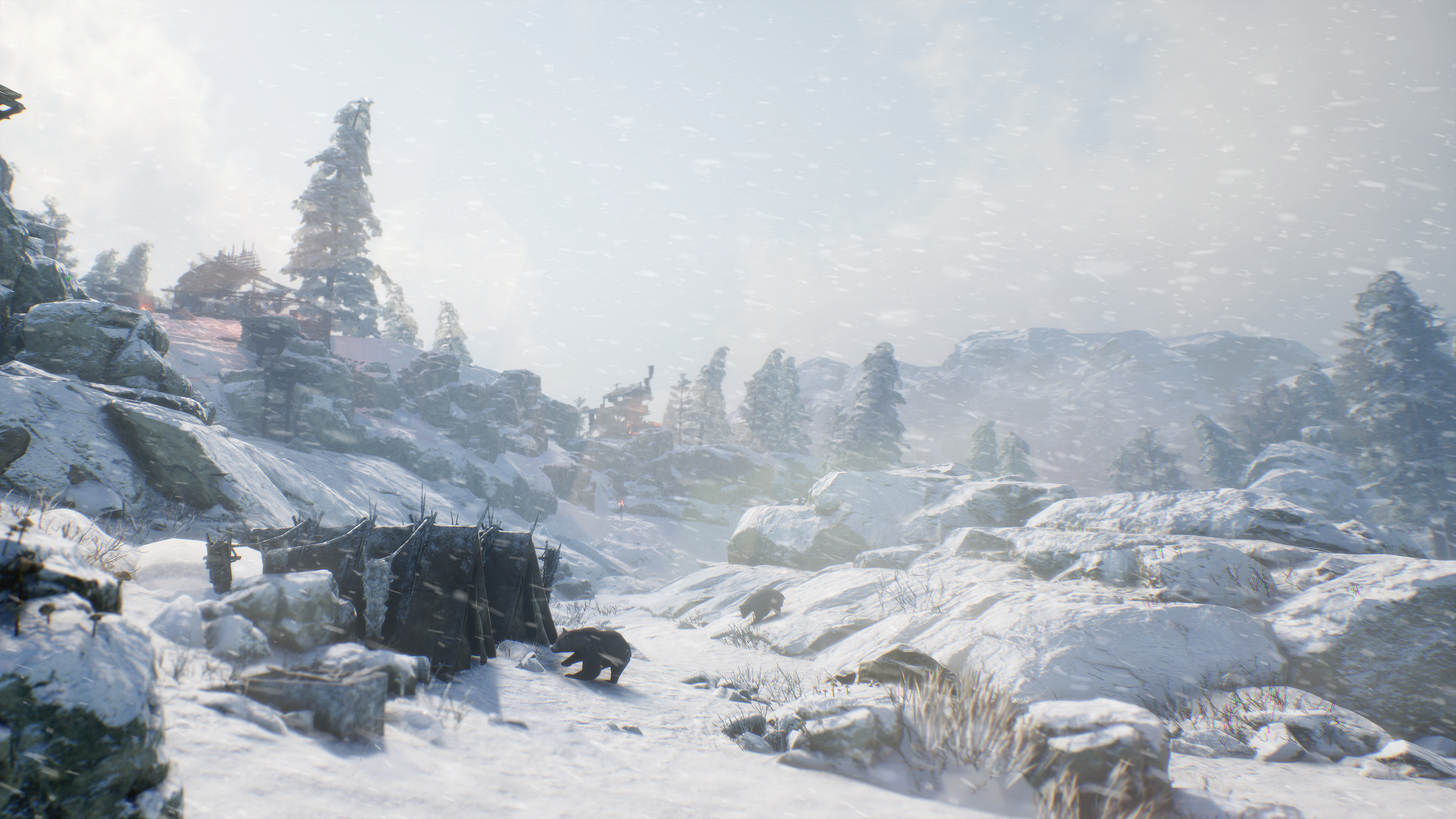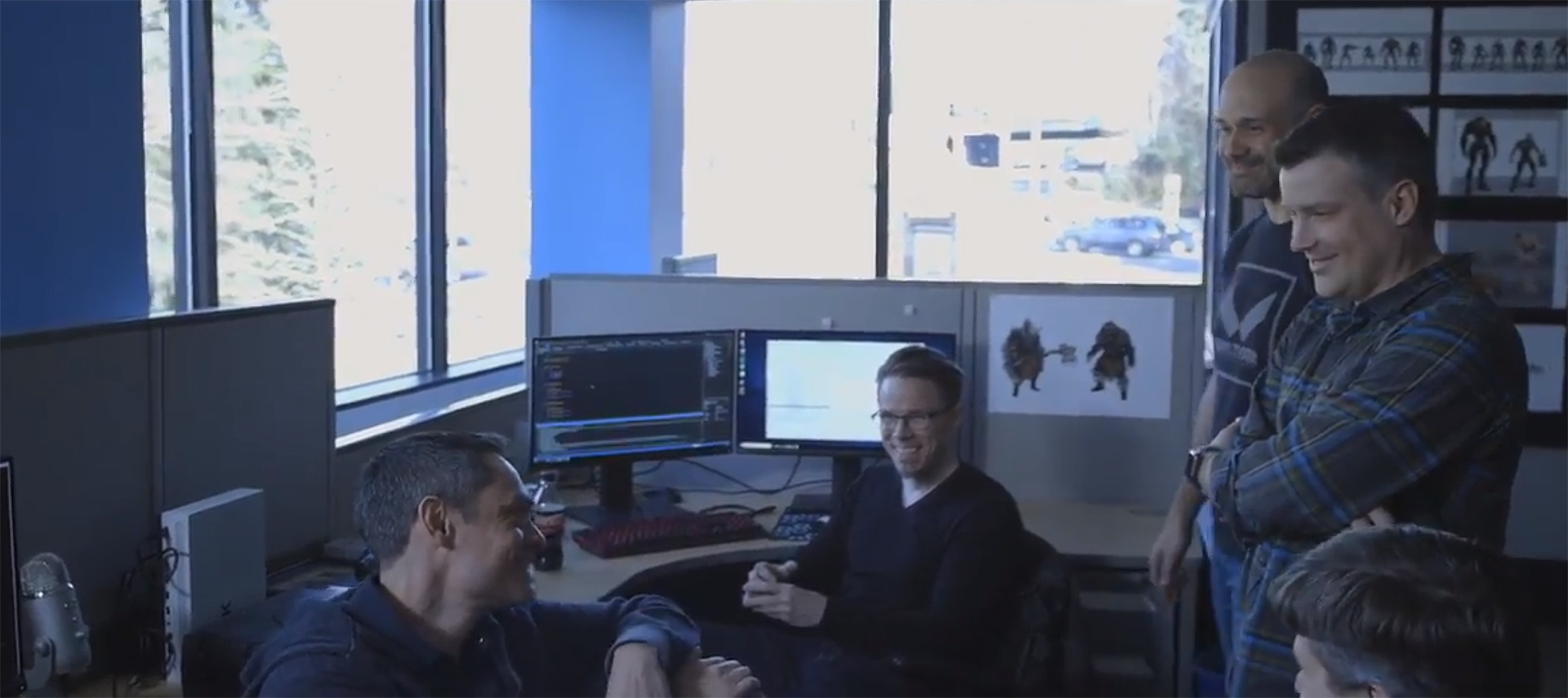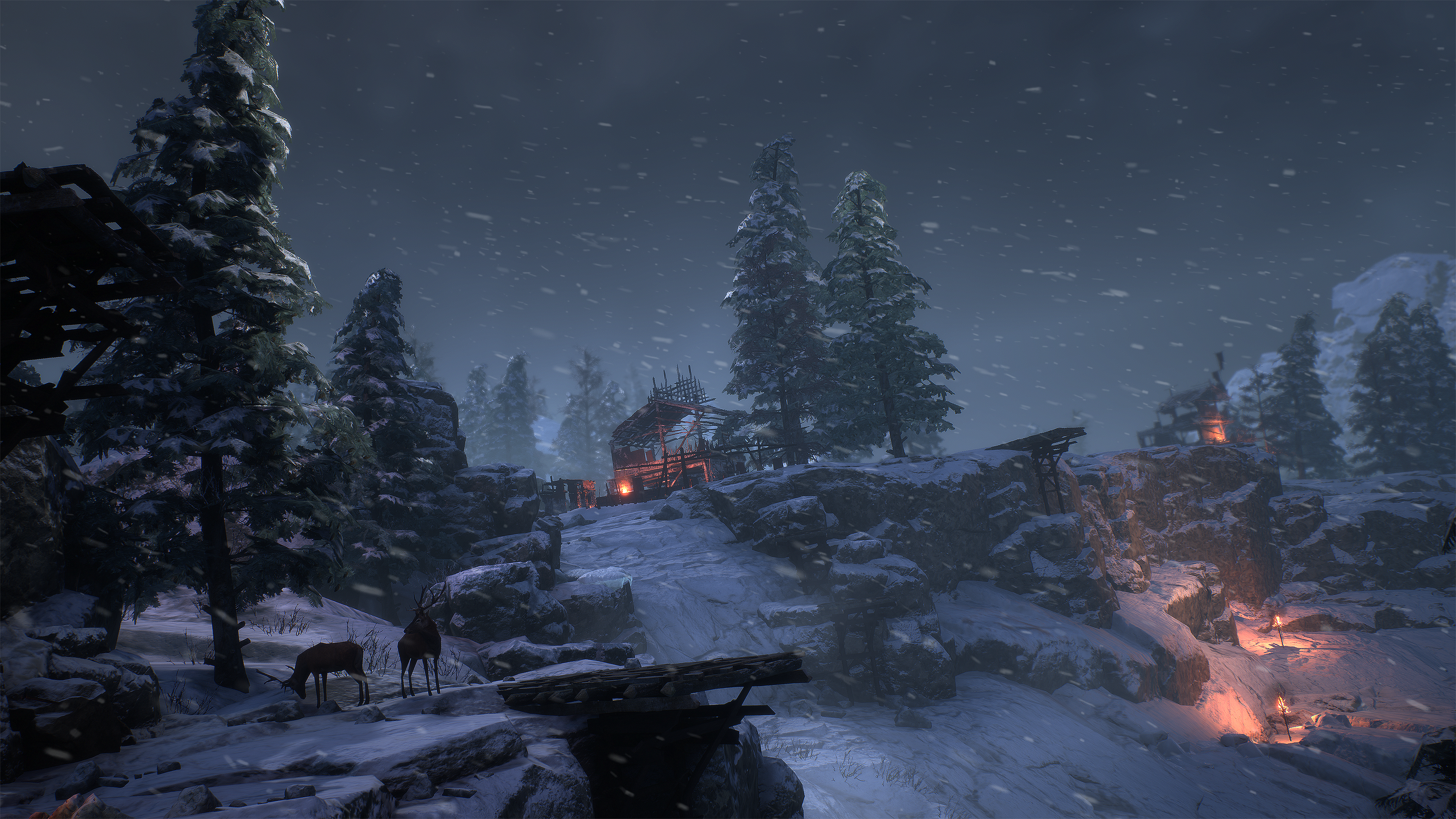Scavengers brings open world chaos to a fascinating blend of PvE and PvP
Our exclusive hands-on with Scavengers, a multiplayer survival game that makes competition and cooperation equally viable.
There are some intimidating enemy factions in Scavengers, Midwinter Entertainment's fascinating debut: a strange hybrid that's part survival game, part competitive shooter, and part cooperative exploration game. There's the Scourge, a fleshy parasitic alien horde that endlessly sprouts from the ground, and the Outlanders, a band of desperate rogues hardened by an eternal winter. But neither is as powerful as a single bear.
It's a single bear that finds our lowly group, four survivors shot down from a space station to explore an Earth reclaimed by decades of cold, catastrophic climate change. It's a single bear that chases us until we run into another group of players in a shootout with an Outlander camp. As the final blizzard moves in and the extraction point is marked 500 meters away, it's that single bear that leaves us for easier, distracted prey and cleans up an entire camp of of both NPCs and live players while we scoop up some of their spoils and sprint to the space van.

I'd like to say we did it on purpose, but it was a happy accident (for us at least), the result of overlapping AIs set free in a massive world and set alight with poor human judgement. It's the kind of fun mess typically reserved for single-player open world games—your Far Crys and Fallouts—now a mess we made and experienced together.
As one of the first people to play Scavengers outside of Midwinter, even in its very early state, you don't need to squint too hard to see what the team is aiming for. Think of it like a match-based survival game where you and a team of four explore a massive, randomly generated winter wasteland scrounging for supplies, working towards a common goal with the other couple dozen players scattered about.
I mean, we could've, maybe should've helped Team Bear Food. We wouldn't have collected enough shards without their help, but in a stressful moment we saw an opportunity to take a bigger share of the credit for our unified goal and run. After every match, the team that makes it out with the most shards is declared the winner and given a larger helping of rewards. And the fewer people that make it out alive, the more you and your pals get. So can you blame us?
But if you take a purely adversarial approach and murder players as you meet them, chances are you won't have the manpower to gather enough resources before the final storm moves in and forces you to head back to space. The tension between choosing whether to help or hinder strangers is at the heart of Scavengers, and the stresses of surviving a perilous environment make it much more than a decision influenced by whether you're in the mood for competition or cooperation. Maintaining that tension is Midwinter's greatest challenge.
Making camp
As the former creative director and studio head of the Halo series at 343 Industries, Josh Holmes knows how thrilling first-person combat is made. But as a founder and CEO of Midwinter, his goals for Scavengers are more nuanced (and third-person) than ever, even with a much smaller team.
The biggest gaming news, reviews and hardware deals
Keep up to date with the most important stories and the best deals, as picked by the PC Gamer team.

"Our mission as a studio is the creation of togetherness, which is that feeling that you get when you work together to overcome big obstacles and accomplish great things," Holmes tells me. It's not the mission statement you'd necessarily associate with devs behind one of the most competitive shooter series ever, but hear me out.
Halo 5's Warzone mode is the most obvious point of comparison, and one Holmes invokes often. He helped make the damn thing, after all. For the unfamiliar, it's a 24-player mode in which taking out AI enemies is as important as keeping enemy players at bay. It's possible to finish a Warzone match without really bothering with other players directly. Objectives and coordination matter more than anything, and Holmes is carrying the same ideas into Scavengers' help-or-hinder ethos.
The survival mechanics are going to press upon you in a way that forces you to take advantage of the materials and options that are available to you.
Josh Holmes, CEO
Layered throughout are a few familiar systems you might recognize from other genres. Characters are divided into classes and each come with unique abilities and class weapons that you can improve over the course of a match with enough salvage found in abandoned settlements and on enemy corpses. I tried out a character that could deploy an extremely familiar bubble shield, and another that could deploy a campfire that didn't just heal, but warmed my entire team. Because, yeah, there are some light survival systems in there too.
Don't recoil too quickly. Holmes knows the stigma that comes with survival games. Babysitting meters, farming materials, constructing items from arbitrary blueprints and recipes—all that's streamlined and fairly unobtrusive in Scavengers. The only meters you need to pay attention to are your warmth and hunger, and both food and fire are aplenty so long as you're willing to take on an enemy encampment or, if you're desperate, take out another team or two for their supplies. I'm the devil on your shoulder, and I'm whispering, do it.
Holmes sees those meters as important pressure points, not arbitrary management systems. "The survival mechanics are going to press upon you in a way that forces you to take advantage of the materials and options that are available to you, and you're going to have to make smart decisions in ways that you manage those resources to survive within the context of the experience."

The intent is to push players into making tough decisions, to keep them moving, to make sure there's never a state of absolute contentment. I'm told Scavengers is meant to be paced like a thriller, where players are always on edge, a game where uncomfortable silences punctuated by bursts of noise and violence (and bears) are the norm.
The importance of staying fed and keeping warm tends to push players towards violence or cooperation with one another, but it's not always enough. If DayZ is proof of anything, it shows that interesting and ambiguous social systems quickly devolve into shooting one another on sight.
We're talking fairly large scale, creative event-driven type stuff.
Daryl Anselmo, UX/Art Director
It's why Scavengers is being developed as a living game, to be updated regularly with drastic meta changes, which means daily, weekly, and seasonal incentives to play both aggressively and peacefully will lead to rewards of all types: cosmetic, XP, and whatever else makes the final cut. Holmes and company make it clear that Scavengers will change often and as much as possible to best support the tenuous social relationships and systemic chaos that makes their project so compelling. So long as we get the floss dance (and yeah, emotes are confirmed), I'm good. No one can touch me when I'm flossing.
We're talking drastic meta changes, too, according to founder and UX and Art Director Daryl Anselmo, who has an incredible beard, I might add. "We're talking fairly large scale, creative event-driven type stuff, " he tells me. Holmes drives it home: "We're unafraid of change." He explains, "For a live service to be really compelling, my opinion is you have to be willing to make those big changes and share them with the community." Anselmo says that while the release notes will include the incremental, small-percentile tweaks and changes to otherwise invisible systems, they want players to adapt to big changes. Scavengers is all about responding to change in a moment's notice, so why not expand that to the beloved meta?
It makes sense that Anselmo looks like an authority on cold temperatures, considering how much has gone into the frigid style and theme of Scavengers.
He walks me through me a progression of images, starting with a photo of Colorado Springs from a nearby hilltop. The next few images layer on more and more concept art, showing a slow, natural progression from 2018 to the freezing wasteland Scavengers is set in. They build towards a natural reference point for the entire aesthetic: a cold, somewhat plausible future (fleshy alien parasites being the exception).

"We're not trying to position ourselves as a Ninja Theory or Uncharted, a Naughty Dog or anything," says Anselmo. "What my strategy is on the art side is instead of going head to head, use a flanking strategy which is coming up with something different." It's working. At times, Scavengers, when the a storm is passing overhead and you're sprinting towards the evacuation vehicle, it evokes scripted sequences from games like The Last of Us and Horizon: Zero Dawn.
That's rarely the case in such an early state, but Scavengers has only just reached a point where the art style can truly start to seep in. Character features are slightly exaggerated, only just so, so that expressions and silhouettes are clearer than an otherwise straight shot at realism might communicate. Some of the more alien architecture references a book Anselmo found about underground structures in Japan, built with colorful lighting and industrial design that pulls your gaze toward labyrinthine arrangements of pipes and valves and strange machinery—it all coalesces to create a familiar sci-fi setting that still manages to feel fresh, a bit left-of-center from the norm.
That slight distance and rearrangement of familiar forms is reinforced by how Scavengers plays. Not quite a perfect circle yet, but it's easy to see the cohesion Midwinter is going for.
Weathering the storm
During the last match of my visit to Midwinter, an ally spots another team busy with a Scourge harvesting event, fighting off waves of fleshy enemies in order to get some shards. All I see is red. Those are our shards. I let my team know, and we go on the offensive for no reason other than pure greed. Three go down without much trouble, but the fourth gets away.
He stalks us throughout the match, following the our tracks in the deep snow, taking potshots on occasion. What a vindictive jerk. My teammates tell me it's Daniel, the animation guy. We never see where the shots are coming from, but they keep coming. I'm on edge, unnerved. Daniel, animation guy, stalks his prey from the shadows.
Nowhere near our collective shard goal, we run into a Scourge nest and kick off our own harvesting event. It's a tough one, with bulbous explosive Scourge spawning everywhere. It doesn't look like we'll thin the horde before the final blizzard moves in and kills us all, but who appears out of nowhere to help? That potshotting stalker, Daniel. It takes me a minute to realize what's happening and I'm severely tempted by instinct to pull the trigger. But I don't. We survive, all thanks to deus ex machina Daniel. First place doesn't feel so great when you got there by being an asshole and relying on the people you screwed over to help you cross the finish line. Aesop has a fable about this, I'm sure.
This wacky, systemic, social experience comes from a game that's so early it's barely hanging together. I can't imagine how it'll play a year from now.

"We have the bones of a dynamic weather system in place. We have the bones of a dynamic time of day cycle in place. We have the bones of deformable snow terrain in place," says Anselmo. "We have the basic foundations of our characters, we have enemies, we have a whole set of modular pieces that we've been using to construct not only residential buildings but some of the more Outlander post-apoc style of structures."
It's true: the bones are there, they work, and they're already quite capable. The team at Midwinter are shy about Scavenger's current status, but it's in a better state and far more interesting than most Early Access releases these days. Even so, Midwinter is making sure those bones are easy to iterate on and rearrange before any sort of public playtests, due sometime in 2019. But even this early, I can't say I've played anything quite like Scavengers.
Within the span of just a few matches, I was saved by the someone I terrorized, counter-ambushed in an dilapidated cathedral (a story for another time), and used a bear, a single bear, as a weapon in an online multiplayer game with great success. And that's a dream come true.
Sign up for a chance to playtest Scavengers early next year at the official website.
James is stuck in an endless loop, playing the Dark Souls games on repeat until Elden Ring and Silksong set him free. He's a truffle pig for indie horror and weird FPS games too, seeking out games that actively hurt to play. Otherwise he's wandering Austin, identifying mushrooms and doodling grackles.


